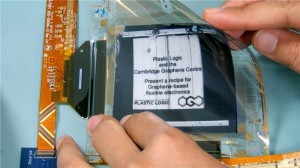
“This is a significant step forward to enable fully wearable and flexible devices .”
-Andrea Ferrari, Director of the Cambridge Graphene Centre
There has been quite the buzz around graphene lately. With this material being among the strongest and most lightweight known, it has the potential to revolutionize industries from healthcare to electronics. And revolutionize is exactly what the Cambridge Graphene Centre (CGC) and Plastic Logic have set out to do.
With the CGC’s graphene expertise and Plastic Logic’s already developed technology for flexible electronics, the two came together to demonstrate the first graphene-based flexible display.
This from University of Cambridge:
The new prototype is an active matrix electrophoretic display, similar to the screens used in today’s e-readers, except it is made of flexible plastic instead of glass. In contrast to conventional displays, the pixel electronics, or backplane, of this display includes a solution-processed graphene electrode, which replaces the sputtered metal electrode layer within Plastic Logic’s conventional devices, bringing product and process benefits.
Those involved with this project believe that this will accelerate the commercial development of graphene and be the first step toward flexible electronics.
“The potential of graphene is well-known, but industrial process engineering is now required to transition graphene from laboratories to industry,” said Indro Mukerjee, CEO of Plastic Logic. “This demonstration puts Plastic Logic at the forefront of this development, which will soon enable a new generation of ultra-flexible and even foldable electronics.”
Want more information on graphene? Check out the research published in our Digital Library, as well as full open access studies on the latest science in graphene.


